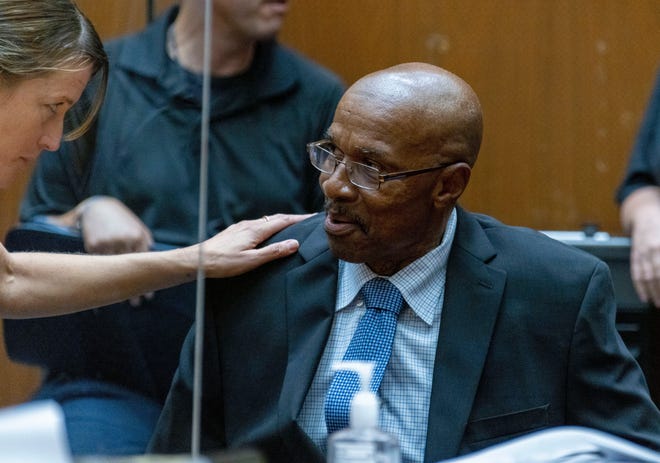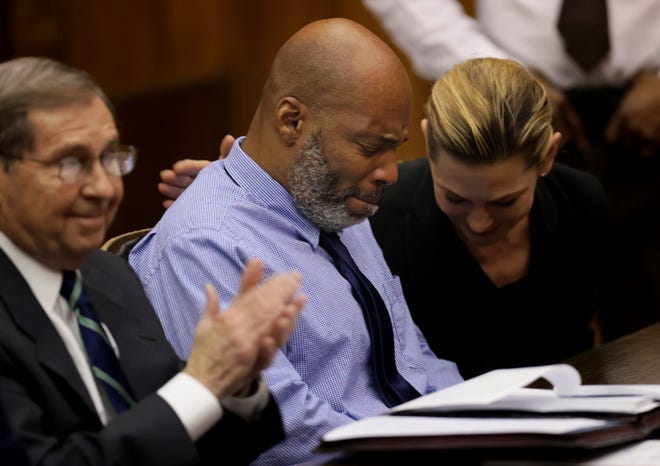A Florida man who served more than 34 years of a 400-year sentence for an armed robbery conviction was released Wednesday after prosecutors discovered he was likely misidentified.
The release of 57-year-old Sidney Holmes comes less than a week after a New York man, Sheldon Thomas, was freed after 18 years following a wrongful murder conviction.
The week before Thomas’ release, Maurice Hastings was declared innocent in California after nearly 40 years in prison.
All three men were exonerated after conviction review units in local prosecutors’ offices reinvestigated their cases. These units, also called conviction integrity units, have grown exponentially in recent years and experts say their impact could stretch beyond freeing the wrongfully incarcerated.
“A CIU both looks back to identify cases in the past that need to be revisited,” said Marissa Bluestine, assistant director of the Quattrone Center for the Fair Administration of Justice at the University of Pennsylvania Law School. “But it’s also learning from that error to prevent those errors from happening in the future.”
What are conviction review units?
Conviction review units conduct extrajudicial investigations into past convictions to determine if they should be vacated because the person who was convicted is innocent or because the process of convicting them was flawed, said Bluestine, who ran the Pennsylvania Innocence Project for a decade.
She said some units also conduct audits of cases involving bad actors and issue case corrections, where prosecutors determine a person was convicted of a more serious crime than they should have been and adjust sentencing.
Some units have multiple attorneys, investigators and support staff. However, others are essentially “one-man or one-woman shows,” said Jessica Weinstock Paredes, a researcher at the National Registry of Exonerations.
“My experience and my visceral impression based on years of talking to these units is several of them could use a lot more help and if there were more resources and more funding would be bigger and would be producing more,” she said.
How many conviction review units are there?
The first conviction review units emerged in the late 2000s and there are now more than 115 in the country’s more than 2,500 prosecutor’s offices, according to Bluestine.
“It’s been a leapfrog forward, but there’s still quite a ways to go to getting it a little bit more ubiquitous throughout the system,” she said. “I think people are starting to demand it more and request it more.”
How many people have been exonerated?
Conviction review units have been involved in more than 670 of the country’s over 3,280 exonerations, according to the National Registry of Exonerations. The most common contributing factors leading that lead to an exoneration are official misconduct, perjury or false accusation, false or misleading forensic evidence, false confession, mistaken witness identification and inadequate legal defense, Paredes said.
More than half of the 96 units listed on the registry’s website have not produced an exoneration. Bluestine said older units in large jurisdictions not having an exoneration could be a cause for concern, but generally, it is a reflection of how long and challenging reinvestigations can be.

How do conviction review units exonerate the wrongfully convicted?
Unlike in an appeal, conviction review units often work with organizations like the Innocence Project and defense attorneys to reinvestigate cases, Bluestine said.
“Under post-conviction laws, it’s very onerous for somebody to get into court to overturn their conviction,” she said.
It can be difficult to track down witnesses who are willing to testify or find physical evidence that can be tested, Bluestine said. Even if prosecutors believe someone is innocent, they may not be able to get back into court, she said.
Bluestine pointed to the case of Lamar Johnson, who was freed in February after spending nearly three decades wrongfully imprisoned for murder. Missouri’s attorney general’s office fought to keep Johnson in prison, but a state law was passed to make it easier for prosecutors to get new hearings when there is fresh evidence of a wrongful conviction.

The final decision is then up to the judge, Bluestine said. The process includes “extraordinary obstacles” and could take years, she said.
“It’s an extraordinary effort which requires dedicated resources, but it also requires luck and a favorable judicial environment,” she said.
Conviction review units have improved, but need more resources
Conviction review units have made meaningful changes in their structure that lean toward “values of transparency, flexibility and independence,” Bluestine said
She said most units were initially run by career prosecutors, but now more than half are led by a person with experience as a defense attorney.
Bluestine said if run well, these units could have a broader impact on how prosecutor’s offices are run, but they need more support.
“You can announce a unit, but if you’re not resourcing it, giving it the right independence, giving it the right flexibility, giving it the right amount of transparency, or allowing it to be transparent, then it really is an open question about whether it’s a sincere effort or not,” she said.
Dig deeper
Contributing: The Associated Press
Contact Breaking News Reporter N’dea Yancey-Bragg at nyanceybra@gannett.com or follow her on Twitter @NdeaYanceyBragg


